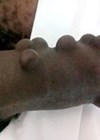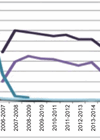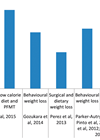Features
Purple urine bag syndrome
Purple urine bag syndrome (PUBS) is an uncommon phenomenon where the tubing and urinary catheter bag is noticed to undergo purple discolouration. This has been linked with urinary tract infections (UTI), chronic debilitated states and prolonged catheterisation. PUBS was noticed...
The surgical management of female stress urinary incontinence in a post-mesh era
Trends in surgical management of women with stress urinary incontinence (SUI) have changed in recent times, mainly due to the ‘High Vigilance Pause’ placed on the use of mesh for SUI (and prolapse) surgery in July 2018 following an independent...
The Re-humanising Revolution: Breaking the conspiracy of silence
Over the last few years, the mental and emotional wellbeing of those who work in medicine has come under scrutiny. The author introduces a new resource. Working in healthcare has always been stressful but never more so than today. In...
Intravesical GAG replacement therapies for bladder pain syndrome / interstitial cystitis – an update
The barrier function of the glycosaminoglycan (GAG) layer of the urothelium was identified by Parsons in 1975, and intravesical therapies to treat chronic inflammatory conditions of the bladder were developed soon after. However, the active role of the urothelium in...
Benign prostatic hyperplasia: what are the benefits and harms of various surgical management options?
Benign prostatic hyperplasia (BPH) is characterised by stromal and epithelial prostatic cell hyperplasia. The enlarged prostate may be associated with voiding and storage lower urinary tract symptoms (LUTS). These have been predominantly attributed to bladder outlet obstruction (BOO), assumed to...
Mechanisms and prevention of catheterisation associated urethral injury (CAUI)
Urethral catheterisation is a common procedure performed by health professionals across different grades and specialties in a variety of clinical settings. An estimated 15-25% of hospitalised patients have a urinary catheter inserted during their inpatient stay and up to 13%...
Artificial penile pearls: what every Urologist should know!
Penile implants are inert objects placed beneath the skin of the penis through an incision. These are variously referred to as Yakuza beads, pearls, ball bearings, speed bumps, penile marbles, inserts, etc. The term ‘penile implant’ described here should not...
Mesh in urological surgery in the UK – background, reviews and current status
All UK urologists, unless they have been on a 10-year silent retreat, are by now aware of the controversy surrounding surgical use of mesh in general and urological / urogynaecological use of mesh for the surgical treatment of stress urinary...
Getting it Right First Time in urology: the implementation phase
The Getting it Right First Time (GIRFT) programme is the largest and most comprehensive initiative to improve the quality and efficiency of individual clinical services that the NHS has ever instigated. The programme falls under the auspices of NHS Improvement...
Practical surgical management of chronic testicular pain
Chronic testicular pain (CTP) is defined as constant or intermittent, unilateral or bilateral testicular pain of more than three months’ duration, which significantly interferes with the daily activities of the patient prompting medical advice [1-4]. This condition is commonly seen...
Urodynamics in review: stress urinary incontinence in women produced by the Urodynamics Committee of the ICS
Urodynamic studies (UDS) are the best tools to objectively assess the lower urinary tract dysfunction (LUTD) of various aetiologies [1]. According to the general understanding and consensus of the medical community UDS should be performed only when they will change...
Optimising weight loss advice in obese women with urinary incontinence: a review
Background The National Institute for Health & Care Excellence (NICE) guidance specifies that women with a body mass index (BMI) of over 30, combined with urinary incontinence or overactive bladder, should be advised to lose weight [1]. A BMI over...














